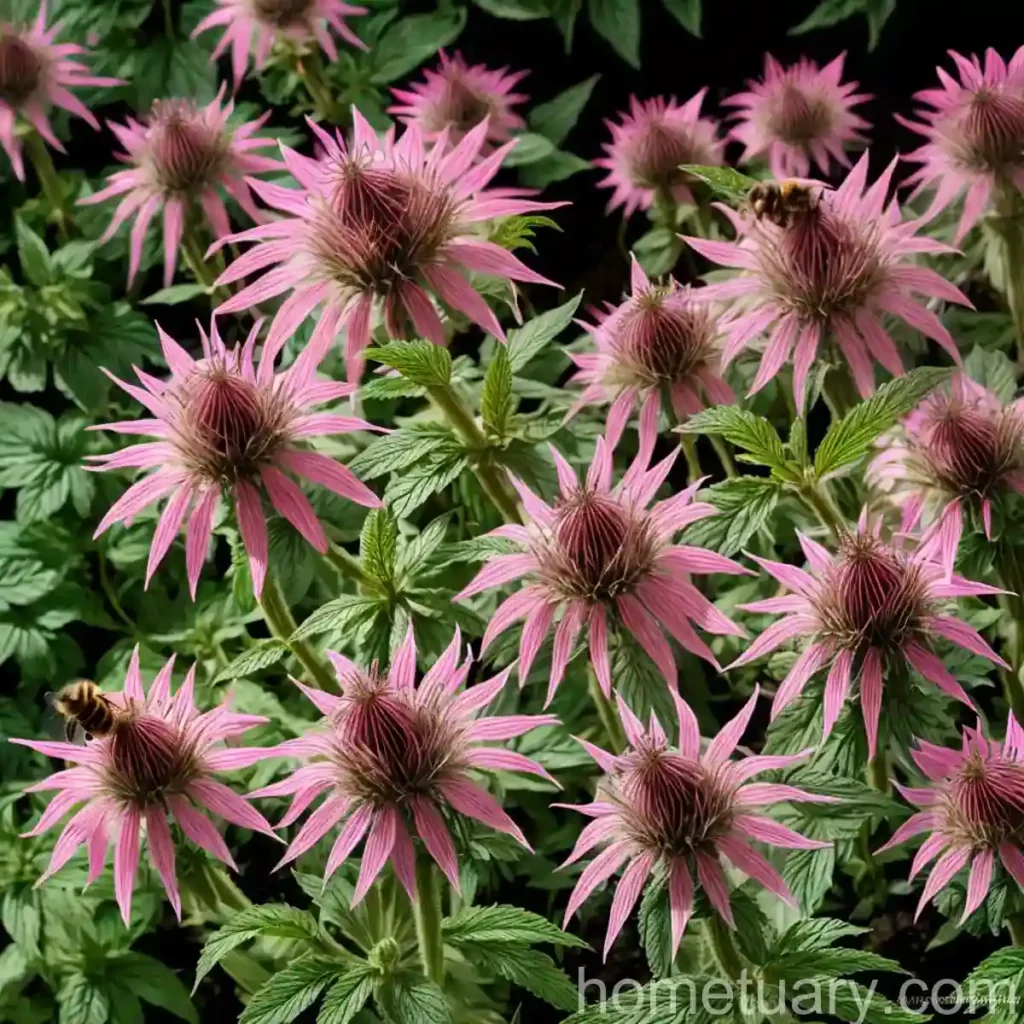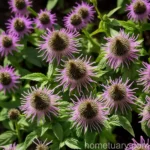Bee Balm (Monarda didyma ‘Pink Lace’) – A Garden Gem with Multiple Uses
Introduction
Plants play a significant role in our lives. They beautify our surroundings, provide fresh air, and offer various uses from medicinal to ornamental. One such revered plant is the bee balm (Monarda didyma ‘Pink Lace’). This article will take an in-depth look at this plant, exploring its culture, uses, care, and interesting facts.
What is bee balm (Monarda didyma ‘Pink Lace’)?
Bee balm, scientifically known as Monarda didyma ‘Pink Lace’, is a flowering perennial plant belonging to the mint family, Lamiaceae. It is native to North America and is cherished for its vibrant pink flowers and aromatic foliage. The common name ‘bee balm’ derives from the plant’s attractiveness to bees, butterflies, and hummingbirds due to its abundant nectar.
Key Takeaways
To gain a profound understanding of bee balm (Monarda didyma ‘Pink Lace’), it’s crucial to delve into various aspects such as its culture, uses, care, and propagation. Let’s explore each of these elements thoroughly.
Culture
Water
Bee balm plants thrive in moist but well-drained soil. It is essential to maintain consistent moisture, especially during dry spells, to ensure healthy growth and prolific flowering.
Sunlight
They prefer full sun to partial shade. Providing adequate sunlight is crucial for stimulating abundant flower production and maintaining overall plant vigor.
Fertilizer
Applying a balanced, slow-release fertilizer in spring can aid in promoting robust growth and enhancing the plant’s blooming potential. Ensure the fertilizer is evenly distributed around the plant and gently worked into the soil.
Soil
Bee balm plants prefer moderately fertile soil with a slightly acidic to neutral pH. Amending the soil with organic matter can improve its texture and fertility, creating an ideal environment for the plant to flourish.
Pruning
Regular pruning is beneficial for bee balm plants to remove spent flowers and control their spread. This encourages the growth of new, healthy shoots and prolongs the blooming period.
Propagation
Propagation of bee balm can be achieved through division or seed sowing. Dividing the clumps every 3-4 years not only helps maintain plant health but also provides an opportunity to propagate and expand the bee balm population in the garden.
Container Popularity
Bee balm can thrive in containers, making it a versatile choice for gardeners with limited space. When growing bee balm in containers, ensure the pots have sufficient drainage and provide the plant with the required care, including regular watering and adequate sunlight.
Uses
The bee balm plant serves a multitude of purposes, ranging from ornamental to medicinal. Understanding its diverse uses can further deepen our appreciation for this remarkable plant.
Ornamental Value
Bee balm is renowned for its stunning, showy flowers that add a splash of color to gardens and landscapes. Its vibrant pink blooms, along with its attractive foliage, make it an eye-catching addition to any garden.
Medicinal Properties
The aromatic leaves of bee balm contain essential oils that have antibacterial and antifungal properties. Its leaves can be used to brew a soothing tea known for its calming effects and potential health benefits.
Attracting Pollinators
Bee balm is a pollinator magnet, drawing bees, butterflies, and hummingbirds due to its abundant nectar. By planting bee balm, gardeners can contribute to the well-being of these essential pollinators while enhancing the ecological balance in their surroundings.
Companion Plant
It serves as an excellent companion plant, aiding in the prevention of pests and diseases in proximity to other plants in the garden. Its aromatic foliage acts as a natural repellant, deterring certain harmful insects.
Culinary Uses
The petals of bee balm flowers are edible and can be used to add color and flavor to salads, beverages, and desserts. They impart a subtle, citrusy taste, enriching various culinary creations.
Common Diseases
While bee balm is a relatively resilient plant, it is susceptible to certain diseases that can affect its health and vitality. Understanding these common diseases is crucial for effective plant care and disease prevention.
Powdery Mildew (Erysiphe cichoracearum)
Powdery mildew is a fungal disease that manifests as a powdery, white substance on the upper surfaces of leaves. It can weaken the plant and inhibit its growth if not addressed promptly.
Leaf Spot (Pseudomonas)
Leaf spot, characterized by the appearance of dark, water-soaked lesions on the leaves, can be caused by various pathogens. It can lead to defoliation and impact the plant’s overall vigor.
Botrytis Blight (Botrytis cinerea)
Botrytis blight, also known as gray mold, can affect bee balm during periods of prolonged humidity. It presents as fuzzy, gray spores on the plant’s flowers and foliage, potentially leading to their decay.
Downy Mildew (Peronospora sp.)
Downy mildew is a common disease that can cause yellowing and browning of the leaves, often accompanied by a fuzzy, gray growth on the undersides. It thrives in moist conditions and can compromise the plant’s health.
Disease Diagnosis
Proper diagnosis of diseases affecting bee balm is essential for implementing targeted treatment measures and preventing the spread of infections. Understanding the symptoms and signs of common diseases is crucial for accurate diagnosis.
Powdery Mildew Diagnosis
Powdery mildew is identified by the appearance of white, powdery patches on the upper surfaces of the leaves. These patches may later spread to the stems and buds, signaling an infestation.
Leaf Spot Diagnosis
Characteristic dark, water-soaked lesions on the foliage serve as a clear indicator of leaf spot disease. As the disease progresses, these lesions may enlarge and merge, causing extensive damage to the leaves.
Botrytis Blight Diagnosis
The presence of fuzzy, gray mold on the flowers and foliage of bee balm plants is a strong indication of botrytis blight. Additionally, the affected plant parts may exhibit signs of decay and deterioration.
Downy Mildew Diagnosis
Downy mildew is recognized by the yellowing and browning of the leaves, often accompanied by a fuzzy, gray growth on the undersides. The plant’s overall vigor may also decline, further highlighting the presence of the disease.
Common Pests
In addition to diseases, bee balm plants are susceptible to certain pests that can compromise their health and appearance. Identifying and addressing these common pests is crucial for maintaining the well-being of bee balm in the garden.
Spider Mites (Tetranychidae family)
Spider mites are tiny pests that feed on the sap of bee balm plants, causing stippling and discoloration of the leaves. Severe infestations can lead to leaf drop and decreased plant vitality.
Aphids (Aphidoidea superfamily)
Aphids are small, soft-bodied insects that congregate on the tender new growth of bee balm, sucking sap from the plant. Their presence can cause distortion of leaves and the development of sticky honeydew, fostering sooty mold growth.
Whiteflies (Aleyrodidae family)
Whiteflies are tiny, winged insects that congregate on the undersides of bee balm leaves, feeding on plant sap. Their infestations can lead to yellowing, wilting, and premature leaf drop.
Botanist’s Tips
As a plant scientist with a passion for bee balm, I’ve accumulated valuable insights and tips to assist fellow enthusiasts in cultivating this captivating plant. Here are some expert recommendations for successfully growing and nurturing bee balm in your garden:
-
Adequate Spacing: When planting bee balm, ensure proper spacing between the individual plants to promote air circulation and reduce the risk of disease development.
-
Mulching: Applying a layer of organic mulch around bee balm plants can help retain soil moisture, regulate temperature, and discourage weed growth.
-
Regular Monitoring: Routinely examine bee balm plants for signs of pests and diseases, intervening promptly if any issues are detected to prevent their escalation.
-
Companion Planting: Pairing bee balm with plants such as echinacea, salvia, and yarrow can create a visually appealing and mutually beneficial garden setting.
-
Deadheading Flowers: Periodically deadheading spent flowers can encourage prolonged blooming and minimize the plant’s self-seeding tendencies in the garden.
Fun Facts
Delving into the world of bee balm reveals fascinating and intriguing aspects that enrich our understanding and appreciation of this remarkable plant. Here are some captivating fun facts about bee balm:
-
Bee balm’s aromatic leaves can be used to create fragrant potpourri, adding a delightful scent to indoor spaces.
-
Native American tribes utilized bee balm for its medicinal properties, including treating fevers, colds, and minor skin irritations.
-
Bee balm’s vibrant flowers are not only visually appealing but also serve as a rich source of nectar for pollinators, supporting biodiversity in the garden.
-
The genus name “Monarda” honors the 18th-century Spanish botanist Nicolás Monardes, highlighting the plant’s historical significance.
Learning about these intriguing aspects of bee balm enhances our connection with nature and the diverse wonders it offers.
Links to External Resources
To further enrich your knowledge and exploration of bee balm (Monarda didyma ‘Pink Lace’), consider delving into the following external resources:
- The Ohio State University Extension – Growing Monarda (Bee Balm)
- Royal Horticultural Society – Monarda
- University of Florida IFAS Extension – Bee Balm for Florida Landscapes
- North Carolina State University Extension – Bee Balm in the Garden
- University of Vermont Extension – Growing Perennial Herbs
These resources offer valuable insights, tips, and research findings to enhance your understanding of bee balm, empowering you to cultivate and appreciate this exceptional plant to the fullest.
In conclusion, bee balm (Monarda didyma ‘Pink Lace’) stands as a botanical gem, revered for its ornamental beauty, medicinal properties, and ecological contributions. By embracing the culture, uses, and care practices associated with this plant, enthusiasts can embark on a rewarding journey of cultivating and nurturing this captivating perennial in their gardens.
Remember, the allure of bee balm extends beyond its aesthetic appeal, making it a valuable addition to diverse landscapes and an essential ally for pollinators. Embrace the enchanting world of bee balm and reap the numerous rewards it has to offer in your own green oasis.















